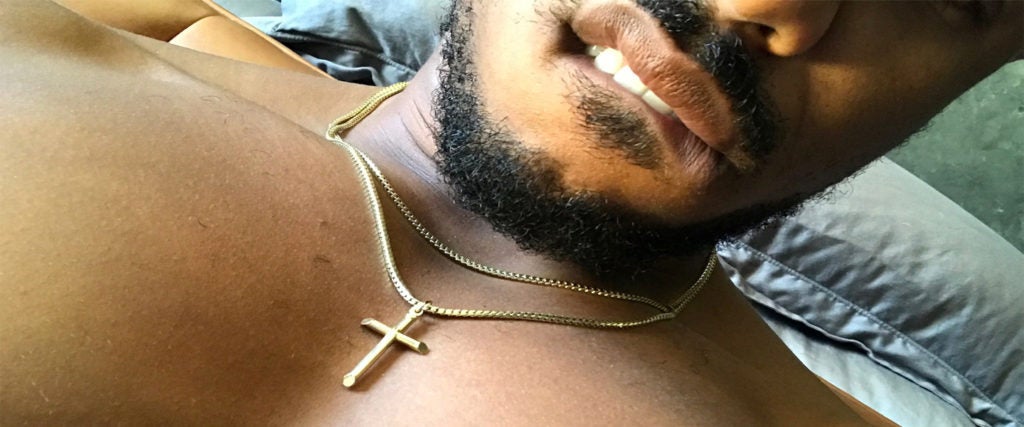In an attempt to encourage civic engagement in the upcoming U.S. election, beloved heartthrob Michael B. Jordan recently dropped a shameless thirst trap on Twitter. “Vote Early,” read the caption replete with a check and ballot emoji, alongside a photo of the star biting his bottom lip and revealing his expansive bare chest in close detail. Just over his shoulder, a couple of pillows in the background reveal that this dispatch is coming directly from his bed.
Vote Early ✅? pic.twitter.com/GHMMefZHYC
— Michael B. Jordan (@michaelb4jordan) October 13, 2020
The reaction wasn’t exactly as expected. Some users responded with the thirst that was so clearly being solicited — “Yes, Daddy!” — but a large contingent replied by saying that the picture was cringeworthy and unattractive. “This is what gives girls the ick,” was one woman’s verdict, while another responded by saying, “This made my coochie dry.” “I never thought Michael B. Jordan could be unattractive,” a third chimed in, “but he has proved me wrong today.”
This is what gives girls the ick lmao https://t.co/995VlwWGqb
— sharonszn?✨ (@sharonszn_) October 14, 2020
this made my coochie dry https://t.co/JT6S1zywG3
— ✧・゚: *✧・゚♡*(ᵘʷᵘ)*♡・゚✧*:・゚✧ (@HENTAlSLUT) October 14, 2020
i never thought michael b. jordan could be unattractive, but he has proved me wrong today https://t.co/ILgAEFgF0s
— maha (@TVRVNTO) October 13, 2020
What was it about the picture that failed to hit the mark?
The common theme, according to these naysayers, is that he was trying too hard to be sexy, which is “fuckboy” behavior. For a man to perform sexiness so deliberately is immature, arrogant and embarrassing, but perhaps worst of all, it’s feminine.
The contrast couldn’t be clearer: When men post obvious thirst traps like this, they’re dragged all day long, both by women and other men. But when women do it, that’s just, well, Instagram. Why?
This is how Instagram thots post.
Delete this https://t.co/vrg7bg61Cf
— laura_xvo (@laura_xvo) October 13, 2020
Traditionally speaking, a sexy man is supposed to exemplify a quiet, effortless masculinity. He should be handsome and visibly muscled, but he should never accentuate his facial features using makeup, celebrate his appearance through selfies or document his many hours at the gym — those things would indicate vanity, which is coded feminine. He doesn’t need to signal his sexual availability by lying around undressed, because his horniness is taken for granted in a way that it isn’t for women. But above all, he should distance himself from femininity by avoiding chick stuff and gay shit, which puts thirst trapping squarely out of bounds.
That we have vastly different codes for how men and women perform sexiness is best revealed by the “If Men Posed Like Women” photo essays that became popular in the feminist blogosphere of the early 2010s. “Visual genderflips are so effective because they tend to highlight … how visual representations of people tend to cater to the male gaze,” Caitlin Welsh wrote at the time. “We’re used to seeing women look sexy and undressed in ads, while men in ads tend to just wear the clothes properly while also looking handsome in the face area.” When men adopt the signifiers associated with women — lying around half undressed, legs akimbo — the result is jarring and comedic — the furthest thing from sexy.
men just don’t sit in sexy silence like this anymore https://t.co/HW5ja4bX9Q
— toni childs (@chynacassell) October 6, 2020
At least, that might be an Anglo way of looking at things. Priya Alika Elias, an Indian writer who has lived in the U.S. and the U.K. and who covers gender issues, says that the performance of sexiness is really different for Indian men. “Our idea of sexiness is shaped in a large sense by our Bollywood actors — that’s who people look to, that’s our example of ‘manly men,’” she writes over Twitter DM. “Those men, to my eye, are much less self-conscious about the fact that they’re trying to be sexy. They’re dressed in super-tight T-shirts, or they’re shirtless. They’ve got gold chains. They preen. They slink. They dance. They smoke cigarettes in sultry fashion. They deliver pick-up lines to the heroines without a trace of embarrassment.”
This, of course, is in direct contrast to the American ideal of masculinity. “The American ideal of sexy is ‘effortless,’” she continues. “Adam Driver is a good example of this — he is very rugged and un-studied, and that ‘natural’ male sexiness that’s a very American ideal of masculinity, which isn’t shared by us.”
Given these cultural differences, I ask Elias what she made of the Michael B. Jordan thirst trap. “I thought it was kinda funny!” she responds. “Like, he was biting his lip in the service of getting people to vote. It was harmless and cute, but not hot.”

